In the vast theatre of the maritime world, few elements play as pivotal a role as the ship propeller. As the beating heart of a vessel, a ship’s propeller is critical to its overall performance and efficiency. Let’s explore the different types of propeller designs for commercial ships and the potential advantages and drawbacks of each.
Fixed Pitch Propellers (FPP): The Steady Sailors
Fixed Pitch Propellers, as the name suggests, have a fixed blade angle, or pitch. They are the simplest and most common type of propeller.
Pros: FPPs are durable, require less maintenance, and are more cost-effective. Due to their simplicity, they are easier to manufacture, repair, and replace.
Cons: Their inability to adjust pitch can lead to less efficient fuel consumption under varying conditions. They also lack the maneuverability of variable pitch propellers.
Controllable Pitch Propellers (CPP): The Flexible Navigators
Controllable Pitch Propellers can adjust their blade angle while the propeller is in operation, providing greater flexibility and control.
Pros: CPPs allow for better fuel efficiency as they can adjust to different operating conditions. They also provide improved maneuverability and allow for easy reversal of thrust without changing the rotation of the propeller shaft.
Cons: The more complex design and mechanism of CPPs mean they are more expensive to produce, install, and maintain.
Ducted Propellers (also known as Kort Nozzles): The Power Players
Ducted propellers are enclosed in a cylindrical shroud or duct, which helps guide the water flow across the propeller blades.
Pros: Ducted propellers can provide higher thrust at low speeds, making them suitable for towing and other applications requiring high bollard pull. They also offer some protection to the propeller from debris and other potential damage.
Cons: The efficiency benefits of ducted propellers diminish at higher speeds. They are also more complex to design and manufacture than standard propellers.
Contra-Rotating Propellers: The Dynamic Duo
Contra-Rotating Propellers consist of two propellers placed one behind the other, rotating in opposite directions.
Pros: These propellers can provide greater efficiency as the rear propeller can recover energy lost in the swirl of the front propeller. They can also provide higher speeds and better maneuverability.
Cons: The complex design and installation of contra-rotating propellers mean they are more expensive and require more maintenance. They also create more noise and vibration than single propeller systems.
Choosing the right propeller design for a commercial ship involves balancing various factors, including the vessel’s intended use, operational conditions, and budget. A well-chosen propeller can make a significant difference in a ship’s performance, fuel efficiency, and overall operating costs.
Navigating the open seas is as much an art as it is a science. In the vast realm of ship design, the propeller holds a special place. It is the silent hero, propelling ships through the ocean’s challenges, helping us trace our path on the endless canvas of the sea.
